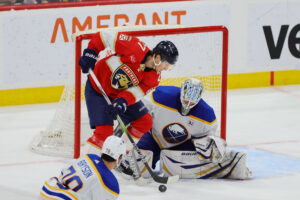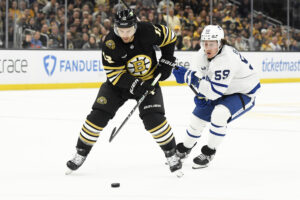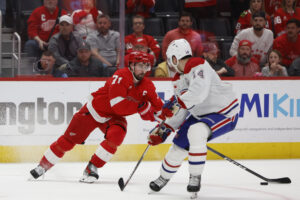The Toronto Maple Leafs had yet another disappointing finish to their NHL season. Despite all that, there’s still something to look forward to in the 2021 NHL Draft. What prospects fit the mold of a Leafs draft prototype?
Toronto Maple Leafs Draft Prototypes: USHL and Swedish Forwards
How To Determine Prototypes
If you want to know the criteria used to find prototypes, check out my Russian prototypes piece and CHL prototypes pieces. For this piece, we will be looking at players the Leafs drafted through the USHL, as well as the Swedish leagues. First, let’s look at how USHL draft-eligibles stack up. Among the Leafs previously selected forwards out of the USHL is Jeremy Bracco.
![]()
Maple Leafs Draft Prototypes: Who Fits From the USHL?
The Leafs have selected just three USHL forwards since 2015 when their Director of Hockey Operations and Scouting took over that position. Below is a list of the USHL draft-eligible players and how they stack up to the three previous USHL selections made by the Leafs. Who meets the most thresholds? Who is a Toronto Maple Leafs draft prototype?

As shown above, there are four positive fits for the Leafs: Matthew Coronato, Matthew Knies, Sasha Pastujov, and Stephen Halliday.
Matthew Coronato
Matthew Coronato, my 25th ranked prospect, is the top USHL fit for the Leafs. Despite me ranking him in the late first, odds are he gets taken around 15th overall, meaning the Leafs would have to move up drastically to get a shot at selecting him. It isn’t impossible, but it is unlikely.
Coronato scored goals at a rate that no other USHL forward has before. He had a 28-game point streak, to go along with a league-leading 48 goals in just 51 regular-season games. His goal-scoring was simply sensational this year. He can play in all situations, with any playing style needed, from anywhere on the ice. You want him to attack the middle and be a menace in the slot? He can do that. Do you want him to stick to the perimeter and tops of the circles, focusing on setting up teammates? Well, he can do that too. Would you rather have him play a shutdown game, staying responsible and playing effectively in his own end? Coronato can do that too. The only concern is his skating ability, which is above average among his peers. But that is easily coachable.
Matthew Knies
Matthew Knies, my 63rd ranked prospect, is expected to go anywhere from the mid-second round to the early fourth, depending on how the draft falls. That said, he is well within reach for the Leafs, if they want him. If taken by the Leafs, he would become the tallest and heaviest USHL forward they’ve selected in recent history. That, to go along with his raw stats and per-game stats, and he meets just about all the criteria needed to be a Maple Leafs fit.
Knies is a big body, who loves to get to the dirty areas and battle for the puck. He has really good offensive skills, with a good feel for his teammates, high-end creativity, and strong hands that allow him to be a good playmaker. Knies also possesses a strong shot, allowing him to be a dual-threat offensive presence. His transitional game, skating, and defensive zone play are all areas of improvement, as is his consistency. If he can pull it all together, he could recapture what made him a pre-season first-round prospect.
Sasha Pastujov
Similar to Coronato, Sasha Pastujov also dominated, but in the USDP ranks. He had moderate success against the USHL competition. Being ranked 45th on my list, he doesn’t get quite the same love as Coronato. He can set up teammates with regularity and has a good sense of where they’ll be when the puck is on his stick. However, his skating simply needs to be better. His defensive game could also stand some improvement. Additionally, his shooting, though improved this season, must continue to advance if he wants to be a dual-threat at the NHL level.
Pastujov is not expected to be available by the time the Leafs are on the clock. He’s projected anywhere from the late first-round to the mid-second. That said, if he slips, the Leafs could be wise to scoop him up.
Stephen Halliday
Finally, the last positive fit for the Leafs is Stephen Halliday. Halliday is a large man and would be the biggest USHL pick for the Leafs since 2015. Additionally, he has the most experience, as he is a redraft player. He went undrafted in 2020, and his raw stats gave him a boost to be a Leafs fit in the later rounds. He is my 157th ranked prospect. That said, if the Leafs wanna take a late flier on an older prospect, he could be their guy.
Halliday is a big-bodied, net-front presence, who uses his size very well. He can move the puck quite well and has some decent offensive upside. Halliday will have to work on his skating moving forward, which isn’t surprising considering his size, but he could provide some good value in a third-line role.
Maple Leafs Draft Prototypes: SHL
As for the Swedish leagues, there are quite a few more fits. In the Swedish ranks, which was divided into two leagues you have the SHL and J20 SuperElit/Nationell. Here are previous selections from those two leagues by the Leafs, which includes Carl Grundstrom.
![]()
Now, here’s how the 2021 class stands up to the Leafs draft history, along with the scores to determine Leafs draft prototypes.


Looking at the list of Swedish league draft-eligible players, there are seven positive fits. Among them are players the Leafs have little-to-no shot of drafting: William Eklund, Isak Rosen, Simon Robertsson, and Oskar Olausson. The other fits, from best to worst, are William Stromgren, Oliver Moberg and Liam Dower Nilsson.
William Stromgren
William Stromgren, my 95th ranked prospect, is a player who can go anywhere from the early second round to the late fourth. There is a good chance he slides to Toronto in the later portions of round two. If selected by the Leafs, he’d be the tallest player taken by the Leafs via the Swedish ranks, and he would also be the lightest. He stands at 6’3” and 176 pounds. His per-game stats in the J20 league, along with his U18 World Juniors performance, give him the boost in fit score.
For Leafs fans, Stromgren is a guy with great potential. His skating is predicated on strength as opposed to fluidity, but he is still fast and can beat defenders off the rush with his speed and strength. Stromgren lives in the slot in the offensive zone and isn’t afraid to drive through or around defenders to get there. He has the hands to pair with his skating to aid in maneuvering around the opposing defender. However, his defensive game needs a lot of work, and his offensive game, with his lanky build, is hard to project. If he hits, he could be a top-six NHLer.
Leafs Draft Prototypes: Oliver Moberg
Oliver Moberg, my 79th ranked prospect, is projected to go anywhere from the mid-third to the end of the fifth round. That lands him squarely in Toronto’s reach. He lands here because of his size, which would make him the tallest and heaviest Leafs draft pick out of Sweden. He is 6’3” and 203 pounds. Additionally, his U18’s play boosted his fit score.
Moberg is not the best skater, but that’s somewhat expected with his size. His defensive game is not the greatest either, though, with added experience, he has the awareness to build that aspect up. Where he truly stands out is how he plays in the offensive zone. Moberg controls the pace of play really well, settling things down and making the smart plays. With his size, decent stickhandling, and poise with the puck on his stick, he looks to be a future bottom-six player. The upside is not great, but he could still make it to the next level with improved skating.
Liam Dower Nilsson
Liam Dower Nilsson, my 73rd ranked prospect, is projected to go anywhere from the late second to the early fourth round. Dower Nilsson gets on the Leafs draft prototypes list because of his U18’s and also his per-game stats in the U20 leagues.
Dower Nilsson has excellent playmaking ability. He uses his high IQ and creative mind to find teammates, as well as create space for himself in order to give his teammates time to get open. He’s also strong in his own end, supporting his defense down low, and using an active stick to disrupt play. Dower Nilsson must work on his skating in order to further improve his odds of being an NHL player. He must also get stronger on his skates and continue to bulk up in the coming years.
Main Photo: TORONTO, ON- Kyle Dubas file photos from the Nylander signing press meeting.(Rene Johnston/Toronto Star) (Rene Johnston/Toronto Star via Getty Images)






